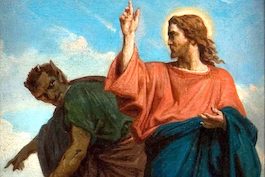"He commands the unclean spirits"
- FATHER SERGE-THOMAS BONINO, O.P.
Mankind's servitude to the devil depicts the misery of man without God.
 The possessed of the Gospels are a terrifying image of the human condition when man has deliberately broken with God. They live in the unclean spirit — in other words, in an inability to enter into relation with the Holy One. Consequently they are raving, mute, blind, deaf, shut off from any genuine relationship with their neighbor. They live in cemeteries and unleash their rage against themselves and against others. In short, a possessed person is like a dead man walking.
The possessed of the Gospels are a terrifying image of the human condition when man has deliberately broken with God. They live in the unclean spirit — in other words, in an inability to enter into relation with the Holy One. Consequently they are raving, mute, blind, deaf, shut off from any genuine relationship with their neighbor. They live in cemeteries and unleash their rage against themselves and against others. In short, a possessed person is like a dead man walking.
The chief of the maleficent spirits is indiscriminately called Satan (thirty-four times in the New Testament) or the devi — in other words, the divider (thirty-three times). He is branded as the evil one and the final petition of the Our Father is a plea to be delivered from him. He is also the Enemy, the Adversary, the one who sows weeds in the field, yet his power is trampled underfoot by the apostles. Depending on the forms that his malice takes, he is described as a liar and the father of lies and a murderer from the beginning, since his lying led man into sin and death. Inasmuch as he draws men into evil, he is the tempter or the seducer. Finally, Satan recapitulates the figures of evil that are depicted in the Old Testament: he is the enormous dragon, the ancient serpent.
This picture would be rather overwhelming if it were not intrinsically related in the New Testament to the victory of Jesus Christ. Indeed, just as the New Testament reveals the depth and universality of sin only at the precise moment when it is pardoned in Christ, so too it insists so much on demonic domination only to highlight the victorious arrival of the Kingdom. The victory was not won without combat. Satan stubbornly insists on preventing the coming of the Kingdom in Jesus. In archetypal fashion, in the manner of a musical overture, Satan tries in the desert, from the very beginning of Jesus' public life, to divert him from his mission. The Passion is from a certain perspective Satan's hour. But it is much more the hour of Christ: Now is the judgment of this world, now shall the ruler of this world be cast out (Jn 12:31). Satan's apparent victory marks his definitive defeat.
 This is Meaghen Gonzalez, Editor of CERC. I hope you appreciated this piece. We curate these articles especially for believers like you.
This is Meaghen Gonzalez, Editor of CERC. I hope you appreciated this piece. We curate these articles especially for believers like you.
Please show your appreciation by making a $3 donation. CERC is entirely reader supported.

Acknowledgement
Father Serge-Thomas Bonino, o.p. "He commands the unclean spirits." Angels and Demons: A Catholic Introduction (The Catholic University of America Press, Washington, DC., 2016).
Published under a fair use provision.
Image: Félix Joseph Barrias's painting of the Temptation of Christ dates to 1860.
The Author

Father Serge-Thomas Bonino, o.p. is a Dominican priest, professor at the Pontifical University of Saint Thomas Aquinas (the Angelicum) in Rome, and the Secretary General of the International Theological Commission. / From Angels and Demons: A Catholic Introduction, The Catholic University of America Press, Washington, DC. Used with permission.
Copyright © 2016 The Catholic University of America Press



